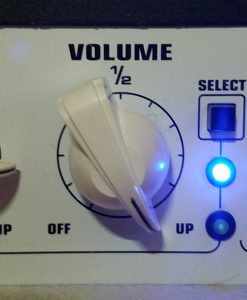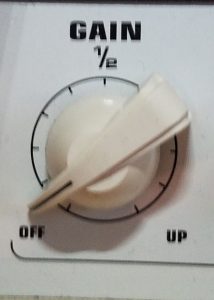Sometimes…. I like it LOUD.
And I’m not just talking car radio loud. I mean shake the walls, rattle the windows, cause the icicles outside to drop and shatter and (even tho’ I have a big yard) make the neighbors consider calling that number. You know the one.
And, yea, I’m wearin’ protection when I do it.
What am I talkin’ about? Why, playing guitar through an AMP, of course!! What else??
Even with my protective, volume-cutting headphones on, when my amp is really cranked I just love that whole-body feeling – the guitar, bass or keys, flying around, bold as love & Jimi, the energy pushing palpably through my frame and lighting up the world around me, creating that singing feedback that cries to the heavens “I SQUEAL, THEREFORE I AM!!”
Oohhh, yea, baby.
But, hey, there are times when I don’t want to endanger the pyramids with my latest licks, or shake passing birds out of their migration triangles. I just wanna lay down some choice parts with the minimum of fuss, but the maximum of tonal splendor… and still have neighbors that smile at me.
The question for years was… how do I do that? How can I record great amp tone while keeping the volume down??
In 2016, the answer came. Ladies & gentlemen, I present to you… the box that has solved my late-night jamming quandaries… the Mesa Cab Clone!!
The Signal Challenger!

We all know that when you push your amp into higher dB levels that a luscious, mesmerizing “cool fro” frizz takes place that adds beautiful, cascading overtones of sexy distortion to whatever notes you’re playing. LOVE that. But when it’s, say, 10 p.m. and your family’s called it a night, you can’t turn it up to eleven.
Sorry, Nigel.
When we want that knock-out punch, without it becoming a weapon of mass destruction, both Strongbad and I turn to the Mesa Cab Clone to help.
Basically, there are three reasons to buy this product:
- You play through an amp live but your sound man doesn’t like mic’ing your amp. You send a Direct Out to the soundboard and it sounds like it’s actually coming out of a cabinet, unlike the Direct Out of most amps.
- You want to be able to play through or record your amp and cabinet at low volume.
- You want to crank your amp to higher levels to achieve that gorgeous, overdriven tube sound, but not with the accompanying high volumes that demolish everything in its wake.
I have used this unit for each of these needs, and in each case it has delivered well. As we shall see, it has its weaknesses, but for these three uses it does have solid solutions that make it worth its weight in sound.
The C.C., as I shall call it, comes in three flavors:
- 4 Ohms
- 8 Ohms
- 16 Ohms
Your choice will depend on the Ohms rating of your particular amp. Match them… or face dire consequences!
This is, by the way, a PASSIVE amp interface, so there’s no power cord; no need to plug this baby in at all. Nice, right?
The Cab Clone is produced to work with amps that are 100 Watts or less. If your amp can implode buildings in a single 5 chords ‘cuz it’s more than that, you’re outta luck.
A Hit to the Front!
The front is where you’ll be doing any tweaking, so let’s start there. Obviously, if you have any ground or phase issues, you know you can just flip either switch to help out. Good to have those there, but they’re not why we’re here. The big, bad prize fighters on either side of the front casing are what deliver the knock-out blows, so let’s focus our attentions there…
On the left you have your D.I. level. Crucial control that. Depending on how I’m using it, I might have it ALL the way down to the left, or somewhat higher. The amount of decibel control you have with this unit is the big reason I bought it, and it really allows for some excellent sonic flexibility.

On the far right, workin’ the speed bag with grit, is the Cabinet Simulator switch. Three options are available to us here:
- Closed back cabinet sound
- Open back cabinet sound
- Vintage cabinet sound
The first option, I admit, I never, ever use. It’s just too out there. It’s raspy, brittle-sounding and just… doesn’t sound good. To my ears, anyway.
The second option? Yea, that’s my go-to. It’s a good sound. Not for everything, mind you. I know one Metal guy who doesn’t like any of the presets here for his genre’s tone. Fair enough. For my Rock/Pop and Rock stuff, I find the Open Back position to be very usable, especially in a song mix setting.
The third option is the darkest option, but it still doesn’t sound bad. I don’t think I’ve used it yet on a song, but if I had a tune with a lot of, say, mandolin, fiddle and high, glistening acoustic guitar, I could settle on this Vintage setting for some nice balance.
One interesting thing about this unit is that the emulations sound a little different based on whether or not you have a real cabinet plugged into the “Thru” port. I think the best versions are when I DO have the cabinet live and plugged in as well. The sound is beefier and, when I’m playing, there just seems to be more dynamic and tonal interaction between my guitar and the resulting sound and tone. Your mileage may vary.
A Jab to the Back!
The speaker cable out of your amp, that would usually go to your cabinet, you’ll put into port marked “Input“, on the far left. Make sure, of course, that you’re using a real speaker cable, not a standard 1/4′ guitar cable.
If you want to monitor through your cabinet live, while at the same time using the C.C. to send a speaker cabinet emulated signal to a board for live use, or to a DAW for recording purposes, then plug a speaker cable into the second port to the right, marked “Thru“, and plug the other end into your speaker cab.
It almost goes without saying, but make sure you know the correct Ohms rating of your amp and have chosen the correct C.C. unit that was made for that rating. Strange and/or quite damaging things can occur if you aren’t careful here!
In the middle is the Balanced Direct Out port. It’s going to give you the best, quietest direct sound. Use an XLR cable and send your signal to a sound board or recording device using this port. It will deliver the sound of your amp with one of the three cabinet simulations added.
The next port, the “Line Out”, I never use. It just sends the same untreated, unsimulated signal out as my amp does through its Direct Out. I hate that sound. Yuck!! So sterile and…. blech! Movin’ on…
The “Headphones” jack is really cool for practicing. It allows you to turn your amp up as loud as you want, use all the effects in your effects loop, and still achieve a cabinet-simulated sound that will have you cheesing through the midnight hours, when no one else will be able to witness your shredding glory.
Too bad. I bet you sound awesome. 😉
Just know that when you’re plugged into the Headphones jack, you are defeating the XLR Balanced Output. It won’t work if you’ve got cans on, in other words.
My Three Best Punches!
Now that we know the beast a bit, lemme show you the three ways I use it to add oomph and punch to my music.
First, when I’m playing live if the sound person doesn’t want to mic my cab, no problem. I send him the cab simulated direct out via XLR and it sounds great. I’ve heard the recordings from the board. Works nicely and makes sound people big fans of you and your rig.
Second, if I’m recording in the studio I always put down two tracks of electric, at least, no matter what part I’m putting down. One is the cabinet mic’d. The other is the D.I. out of the C.C. This is with the cabinet plugged in, obviously.
 A third way I like to use the C.C. is to record it D.I. with no cabinet. This is really fun, ‘cuz I crank my amp volume up quite high. What is produced is that wrecking ball immense brawn that only comes from pushing the amp tubes hard.
A third way I like to use the C.C. is to record it D.I. with no cabinet. This is really fun, ‘cuz I crank my amp volume up quite high. What is produced is that wrecking ball immense brawn that only comes from pushing the amp tubes hard.
Keep in mind that Mesa does not recommend putting your volume on its absolute highest level, as I did for this demo. They obviously don’t want you to blow your tubes, or damage your amp, and then come hunting them down for vengeance. It’s understandable.
I find that I only have to turn the volume up to about 1 o’clock for my amp to get a good, saturated sound anyway. That saves wear and tear on circuitry and tubes, but still gives me the sound I’m yearnin’ for.
I don’t include my cabinet speakers with this; I unplug them from the C.C. If I didn’t I’d have no house left except the quaking timbers that have crushed me right during my guitar solo. Think I’ll not go there.
 With the “D.I. Level” knob turned all the way down, the decibels of the amp turned all the way up is brought to a more normal place in the C.C., so I get all the meat of my circuitry and tubes but the volume is kept low and manageable to I can bring it into Pro Tools without any digital distortion whatsoever.
With the “D.I. Level” knob turned all the way down, the decibels of the amp turned all the way up is brought to a more normal place in the C.C., so I get all the meat of my circuitry and tubes but the volume is kept low and manageable to I can bring it into Pro Tools without any digital distortion whatsoever.
Believe it or not, I hardly put any GAIN on during this kind of feat at all. There’s simply enough strength and meat with the amp pushed to the extreme that I don’t need it.
As you can see in the pic to the right, I have it barely on, just up enough to where the sound comes out of the amp. Anything more and I’m in Metal territory. For some of you, that may be just the uppercut you wanna deliver to the masses. If so… there ya go!
For those of you wanting even more tweak-head information about the C.C., check out THIS LINK which will show you its manual. It doesn’t have a lot more than what I’ve already outlined, but it will give you a better idea of how Mesa views this product and its opinions on its use.
The Sound of Pounding
OK, so I know you prefer to hear the differences, so let’s take a quick sonic journey through a few of the Cab Clone’s options. I’m not going to do them all, ‘cuz, well, like I said, I don’t like ’em all!
And since we always like to have fun with what we do here at SeriousGAS, I decided to use one of my favorite tunes that I just LOVE to play on the electric as our ‘dress-up doll’. If you know it, shout it out in the Comments section so I know I’m not the only one lovin’ this oldie but awesome classic!
 So, onto the recording test. You’re going to hear my three favorite ways to use this box in this order:
So, onto the recording test. You’re going to hear my three favorite ways to use this box in this order:
- the sound of my 2×12 mic’d with a single Audix i5, midcone
- the sound of the SAME performance coming through the C.C. D.I. port
These two tracks you will hear, back and forth, to really showcase the difference between the D.I. and the real cabinet, mic’d, when they both are hooked up and being used together.
The third way you’ll hear, which is the purple waveform, is
- the C.C. D.I. only, with the cabinet unplugged from the back.
This is the option that allows you to crank your amp up as high as it’ll go, but feed it into your DAW at a modest volume. It really changes the sound, as you can imagine. For the better, IF you are going for an amped-up, robust, gritty tone. If you’re into Mr. Mellow-land and comping for a ballad, this probably is not the way to go.
Use the picture below as a visual explanation for clarity as well. The green waveform is the mic’d cab. The yellow is the D.I. with cabinet plugged in. The purple is the D.I. with the cabinet unplugged.

The only thing added to this amp/C.C. signal chain is a little reverb. No other EQ, compression or effects are involved. Thus, keep in mind that these varying tones you hear can be processed further using your own brand of studio magic for your particular songs and productions.
Alright, enough talk. Let’s commence with the A/B tests!!
Attack of the Amp Angels!
Finally, there are times when a power stealer like the C.C. will be very INappropriate. If the whoop, whine and whale sounds of organic, analog feedback, for example, is your thing (I know it is mine!), any type of power soaker is going to be to its detriment.
On the last album I produced for a client (‘Tempus’, by Sweda), we used harmonically complimentary feedback on several tracks and they came out so impactful and energized. Resounding amp angels, summoned by our powerful pups, have genuflected our tracks with blessing!
Capturing these kinds of sound waves though demands in-the-room volume swelling and ultra rocker posing in front of quivering cabinet speakers. I’ve tried producing some ring with just the guitar in front of my DAW monitors while running the C.C., but’s it’s hardly effective.
In short, if you want feedback, you’re just gonna have to record at a time your neighbors won’t hate you.
Or hear you, for that matter. 😮
Worth the Purse!
For the flexibility and extra variety out of my amp that the C.C. provides me, I would make the investment again if given the chance. No regrets here; I use the Clone often enough for the purposes outlined above to make it a winner in my book.
Is every option on it usable? Not for my mixes, but you may find it different based on your specific amp and cabinet. Those variables will make a BIG difference in the sound.
The three options I find usable, however, more than make up for its weaknesses.
And remember, its nearest competition is still hundreds of dollars more expensive.
How about you? Have you ever worked with a power soaker or unit in this genre? What were your results?
Let us know in the Comments. Sharing the G.A.S. wealth is what we’re about here!
Until next time, keep crankin’ the ‘bels and ridin’ the swells, and as always…
… go… make… sounds!!
Teaj

